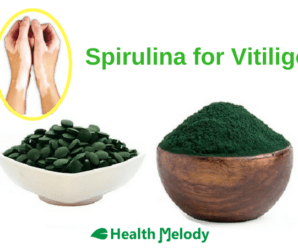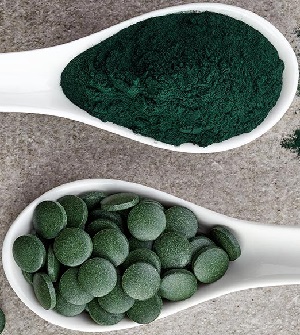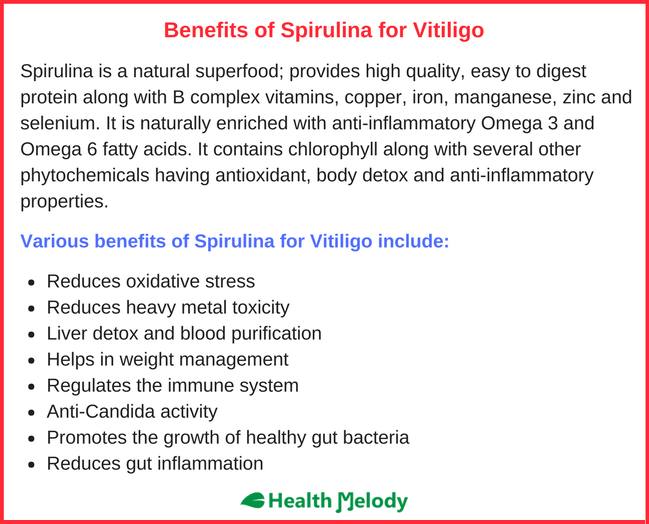
Spirulina for Vitiligo : How it helps?
Does Spirulina help with Vitiligo? Yes, it is. All autoimmune skin disorders are linked to poor gut health and nutritional deficiency. Spirulina is a powerhouse food; provides bioavailable, easy to digest nutrients along with naturally occurring plant chemicals that reduce oxidative stress, inflammation and heavy metal toxicity in the body.
Holistic (natural) healing of vitiligo involves a restricted diet with a minimum intake of animal proteins such as dairy, meat, poultry and eggs. In that case, many people look for some alternative sources of ‘healthy’ proteins. Here comes the role of spirulina- it is a natural food supplement; one of the most nutrient dense foods available on the planet. It is a rich source of ‘easy to digest’ proteins along with a range of vitamins, minerals and phytonutrients.
Spirulina is an organism, a type of blue-green algae that grows in warm, alkaline water. It is rich in chlorophyll and like plants, it uses sunlight to produce energy. Considering its incredible health benefits and rich nutritional profile, it is manufactured commercially by growing in dedicated ponds.
Spirulina is one of the world’s healthiest as well as the oldest foods. Many early age communities in Africa and Mexico consumed spirulina as a source of protein.
Nutritional profile of Spirulina
Serving Size – 7 grams (2 teaspoonfuls) (1)
| Nutrient | % Daily Value |
|---|---|
| Protein | 8% |
| Vitamin B1 | 11% |
| Vitamin B2 | 15% |
| Vitamin B3 | 4% |
| Vitamin B5 | 2% |
| Vitamin B6 | 1.5% |
| Vitamin E | 2% |
| Vitamin K | 2% |
| Folate | 2% |
| Iron | 11% |
| Magnesium | 3% |
| Manganese | 7% |
| Copper | 21% |
| Omega 3 fatty acids | 58 mg |
| Omega 6 fatty acids | 88 mg |
Hence, spirulina is a very good source of protein, vitamin B complex, minerals (iron, copper, manganese, magnesium) and omega 3 and omega 6 fatty acids.
Apart from these conventional nutrients, spirulina is a wonderful source of phytonutrients that provides the blue-green color to spirulina and improves its antioxidant properties.
Read more: Does Vitamin D help with Vitiligo?
Protein in Spirulina
Spirulina is around 55-70% protein by weight. It provides around 600% more protein than tofu when consumed in the same quantity. But, you can’t eat spirulina the whole day, right? That’s why the standard serving of spirulina is just 7 grams per day which is equivalent to 8% of your daily protein requirement. But, the protein provided by spirulina is of very high quality. It contains all the 9 essential amino acids, the building blocks of protein. Also, unlike cereals and vegetables, the protein in spirulina has no thick cell walls, making them easy to digest. Hence, people with vitiligo, having a compromised gut health and sensitive digestive system can easily process the protein in spirulina for growth and development.
| Food | % Protein (By weight) |
|---|---|
| Spirulina | 55-70% |
| Red meat | 27% |
| Beef | 26% |
| Pork | 27% |
| Cheese | 25% |
| Fish (Tuna, Salmon) | 22% |
| Egg | 13% |
| Tofu | 8% |
Minerals in Spirulina
There are many theories and hypothesis that copper, zinc and selenium can help reverse the process of skin depigmentation to stimulate melanin production. (2) That’s why many alternative health experts recommend drinking water stored in copper utensils. Spirulina is a natural source of copper, iron, manganese, magnesium, zinc and selenium. Hence, apart from providing high quality protein, spirulina is quite handy if you are looking for some safe and natural sources of vital minerals.
Essential fatty acids (Omega 3 and Omega 6 fats) in Spirulina
Inflammation is the root of all diseases, including autoimmune skin disorders. Hence, anti-inflammatory essential fatty acids play a vital role in vitiligo healing. The essential fatty acids are called so because the body cannot synthesize them by its own and depends on external sources.
Spirulina contains omega 3 as well as Omega 6 fatty acids in good amounts. Among omega 6 fats, it contains GLA (gamma-linolenic acid) a rare omega 6 fatty acid which is research proven to help in hormonal imbalances, arthritis, obesity, inflammatory bowel syndrome, leaky gut and other inflammatory health conditions. (3, 4)
Apart from spirulina, other sources of GLA include breast milk, evening primrose oil and borage oil.
Phytonutrients in Spirulina
Phytonutrients possess powerful antioxidant activity, helps in body detox and regulates the immune system. The list of phytonutrients in spirulina includes carotenoids, chlorophyll, phycocyanin, polysaccharides, sulfolipids and glycolipids.
As observed in an animal (rat) study, the antioxidant properties of spirulina are at par with blueberry, one of the most potent natural anti-oxidant food source. (5) Also, the ORAC (Oxygen Radical Absorbance Capacity) of spirulina is at par with Blue berry; ORAC value measures the antioxidant ability of a foodstuff.
Phycocyanin is a unique phytochemical with research proven anti-inflammatory properties. (6)
Thanks to these phytonutrients, spirulina works amazingly well in reducing heavy metal toxicity in the body. (7, 8, 9) It is found to be seven times more effective in treating kidney toxicity due to heavy metal poisoning than the controlled diet protocol.
Spirulina for Vitiligo
- Reduces oxidative stress– Many researchers blame high level of hydrogen peroxide in the outermost layer of skin (epidermis) as a prominent cause for skin depigmentation. (10) It occurs due to oxidative stress. The all-natural antioxidant and anti-inflammatory properties of spirulina can help neutralize the free radicals to reduce unnecessary oxidation in your body.
- Reduces heavy metal toxicity– The environmental toxins entering your body are one of the causes for autoimmunity. The active compounds in spirulina can bind with heavy metals in the body to remove them.
- Liver detox and blood purification– Thanks to the high amount of chlorophyll and phytochemicals, spirulina can purify the blood to calm down the immune system and prevents further skin de-pigmentation. Also, spirulina is research proven to reduce liver hepatotoxicity. (7)
- Helps in weight management– Obesity is one of the triggers for autoimmunity. Due to GLA and other active compounds, spirulina stimulates fat metabolism to shed a few pounds of excess body weight to treat obesity. It is a low-calorie superfood which works best to reduce body weight when taken 30-40 minutes before the meals.
- Regulates the immune system– Due to high iron content, spirulina supports the formation of red blood cells, which in turn supply optimum oxygen to all the body cells to fight against cold, flu, infections and allergies. The anti-allergic properties of spirulina are further enhanced by its anti-inflammatory properties. (11)
- Anti-Candida activity– Microbial imbalance in the gut is one of the most prevalent cause for autoimmune health disorders these days. (12) Candida (yeast overgrowth) and other bad bugs overcrowd the good microbes (probiotics) in the gut to cause poor digestion, inflammation and leaky gut syndrome. Spirulina has research proven antimicrobial activity, particularly against Candida. (13, 14, 15)
- Improves the gut health– Reduces gut inflammation, provides bio-available, easy to digest micronutrients, and promotes the growth of healthy gut bacteria to improve the overall gut health. Remember that more than 70% of the immune system lies in the gut. Hence, a healthy gut will eventually lead a calm, regulated immune system to put a check on the autoimmunity.
How to consume and Dosage
Prefer dried powder over spirulina tablets/capsules to reduce the per dosage cost. The taste is quite tolerable; you should get used to it after a few servings. However, if you find its pond scum like taste and flavor too strong to gulp, opt for tablets or capsules, whatever you prefer.

You can take the spirulina powder directly with a glass of water or mix it with your juice, smoothies or green drinks.
The standard daily dosage is 7 grams (2 teaspoonfuls) per day.
Precautions and possible side effects
Spirulina is a natural food supplement which is safe to consume on a daily basis for most of the people.
- Always buy spirulina supplement of a reputed brand to get away with the fear of contamination. The contaminated spirulina can cause mild to severe health complications such as vomiting, nausea, abdominal pain and liver impairment.
- Pregnant women, breast feeding ladies, kids below 12 years of age and people with serious medical conditions should consult their physician before consuming spirulina on a daily basis. Also, if you are consuming blood thinning medicines, then better to avoid spirulina as it also has anti-coagulation properties.
- Spirulina is definitely a welcome addition to your daily diet to ensure optimum intake of vital nutrients and regulate the immune system. However, it should not be taken as a cure for vitiligo. Hence, don’t consume too much of spirulina in the hope of some magical results.
- Always start with slow- consume 1 teaspoon a day for a few days and then increase it to twice a day. It would help you safeguard against any possible side effects.
From where to buy
Check below Amazon links to buy high quality spirulina supplements of reputed and reliable brands:
| USA readers | India readers | UK readers | |
|---|---|---|---|
| Spirulina powder | Click here | Click here | Click here |
| Spirulina tablets | Click here | Click here | Click here |

Need more help?
If you have any more questions, please send me at [email protected] and I will try to answer them with the best of my knowledge.


